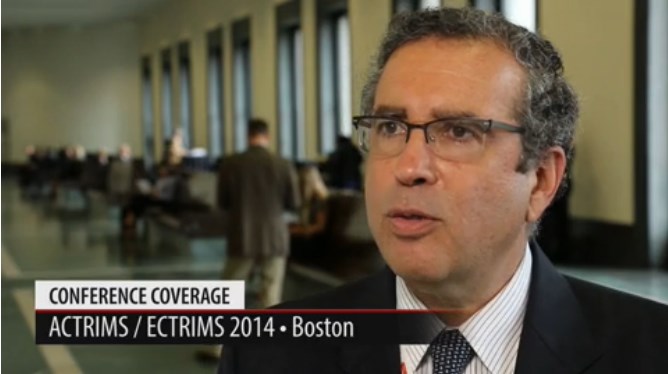User login
BOSTON – A model for explaining the pathogenesis of multiple sclerosis is beginning to come together faster than ever before thanks to a wide range of methods that have allowed researchers to find disease-associated gene variants and examine their interaction with environmental factors, according to Dr. David A. Hafler, professor of neurology and immunobiology at Yale University in New Haven, Conn.
Researchers in the International MS Genetics Consortium have used new techniques to analyze the genomes of large cohorts of patients with MS and revealed many single-nucleotide polymorphism variants that affect immune activation that had not been considered before, allowing researchers to identify which immune cells are involved in the disease, Dr. Hafler said in a video interview at the joint meeting of the European and Americas Committees for Treatment and Research in Multiple Sclerosis.
He and his colleagues also recently have found that areas of the genome that are open to transcription in the T and B cells of patients with MS involve transcription factors that interact with environmental stimuli -- such as smoking, salt intake, lower vitamin D, higher body mass index, and exposure to Epstein-Barr virus -- to lower the threshold of T-cell activation in genetically susceptible individuals, leading to the development of myelin-reactive T cells that secrete pro-inflammatory cytokines such as interleukin-17.
Additional evidence to support the role of immune dysregulation comes from clinical trials in MS that have involved blocking interleukin-17 with the investigational secukinumab and blocking the traffic of T cells to the central nervous system with drugs like fingolimod and natalizumab.
But even with all the knowledge that’s been acquired, Dr. Hafler said there is still much to discover, including how many and which environmental factors play a role; how disease susceptibility variants drive the activation of T cells; and what drives the disease process in secondary progressive MS.
The video associated with this article is no longer available on this site. Please view all of our videos on the MDedge YouTube channel
BOSTON – A model for explaining the pathogenesis of multiple sclerosis is beginning to come together faster than ever before thanks to a wide range of methods that have allowed researchers to find disease-associated gene variants and examine their interaction with environmental factors, according to Dr. David A. Hafler, professor of neurology and immunobiology at Yale University in New Haven, Conn.
Researchers in the International MS Genetics Consortium have used new techniques to analyze the genomes of large cohorts of patients with MS and revealed many single-nucleotide polymorphism variants that affect immune activation that had not been considered before, allowing researchers to identify which immune cells are involved in the disease, Dr. Hafler said in a video interview at the joint meeting of the European and Americas Committees for Treatment and Research in Multiple Sclerosis.
He and his colleagues also recently have found that areas of the genome that are open to transcription in the T and B cells of patients with MS involve transcription factors that interact with environmental stimuli -- such as smoking, salt intake, lower vitamin D, higher body mass index, and exposure to Epstein-Barr virus -- to lower the threshold of T-cell activation in genetically susceptible individuals, leading to the development of myelin-reactive T cells that secrete pro-inflammatory cytokines such as interleukin-17.
Additional evidence to support the role of immune dysregulation comes from clinical trials in MS that have involved blocking interleukin-17 with the investigational secukinumab and blocking the traffic of T cells to the central nervous system with drugs like fingolimod and natalizumab.
But even with all the knowledge that’s been acquired, Dr. Hafler said there is still much to discover, including how many and which environmental factors play a role; how disease susceptibility variants drive the activation of T cells; and what drives the disease process in secondary progressive MS.
The video associated with this article is no longer available on this site. Please view all of our videos on the MDedge YouTube channel
BOSTON – A model for explaining the pathogenesis of multiple sclerosis is beginning to come together faster than ever before thanks to a wide range of methods that have allowed researchers to find disease-associated gene variants and examine their interaction with environmental factors, according to Dr. David A. Hafler, professor of neurology and immunobiology at Yale University in New Haven, Conn.
Researchers in the International MS Genetics Consortium have used new techniques to analyze the genomes of large cohorts of patients with MS and revealed many single-nucleotide polymorphism variants that affect immune activation that had not been considered before, allowing researchers to identify which immune cells are involved in the disease, Dr. Hafler said in a video interview at the joint meeting of the European and Americas Committees for Treatment and Research in Multiple Sclerosis.
He and his colleagues also recently have found that areas of the genome that are open to transcription in the T and B cells of patients with MS involve transcription factors that interact with environmental stimuli -- such as smoking, salt intake, lower vitamin D, higher body mass index, and exposure to Epstein-Barr virus -- to lower the threshold of T-cell activation in genetically susceptible individuals, leading to the development of myelin-reactive T cells that secrete pro-inflammatory cytokines such as interleukin-17.
Additional evidence to support the role of immune dysregulation comes from clinical trials in MS that have involved blocking interleukin-17 with the investigational secukinumab and blocking the traffic of T cells to the central nervous system with drugs like fingolimod and natalizumab.
But even with all the knowledge that’s been acquired, Dr. Hafler said there is still much to discover, including how many and which environmental factors play a role; how disease susceptibility variants drive the activation of T cells; and what drives the disease process in secondary progressive MS.
The video associated with this article is no longer available on this site. Please view all of our videos on the MDedge YouTube channel
AT MSBOSTON 2014
